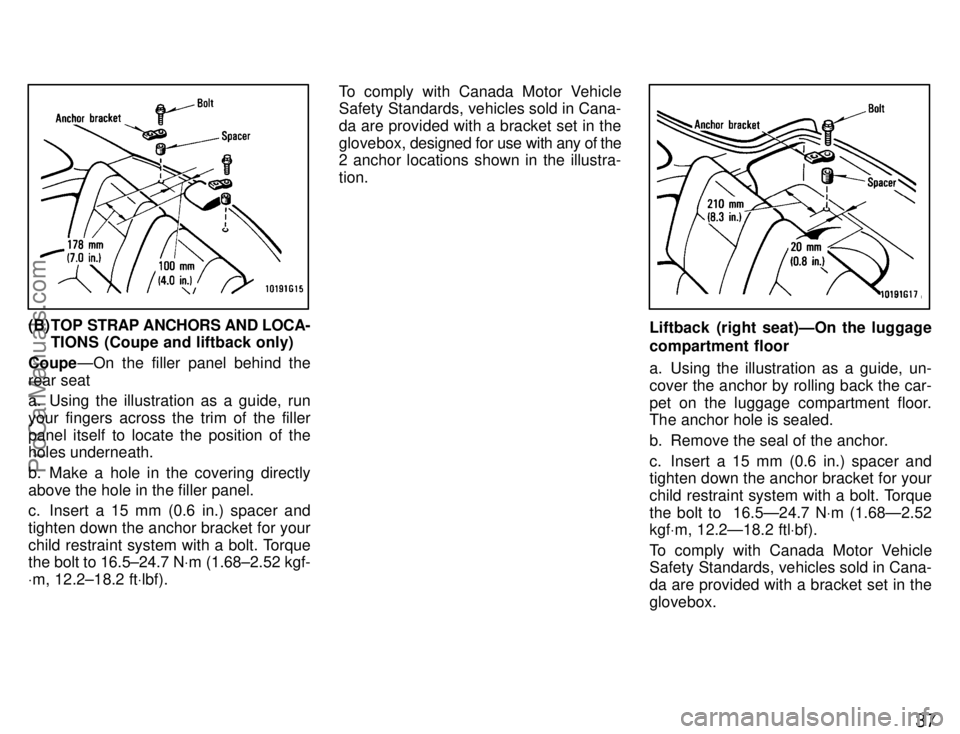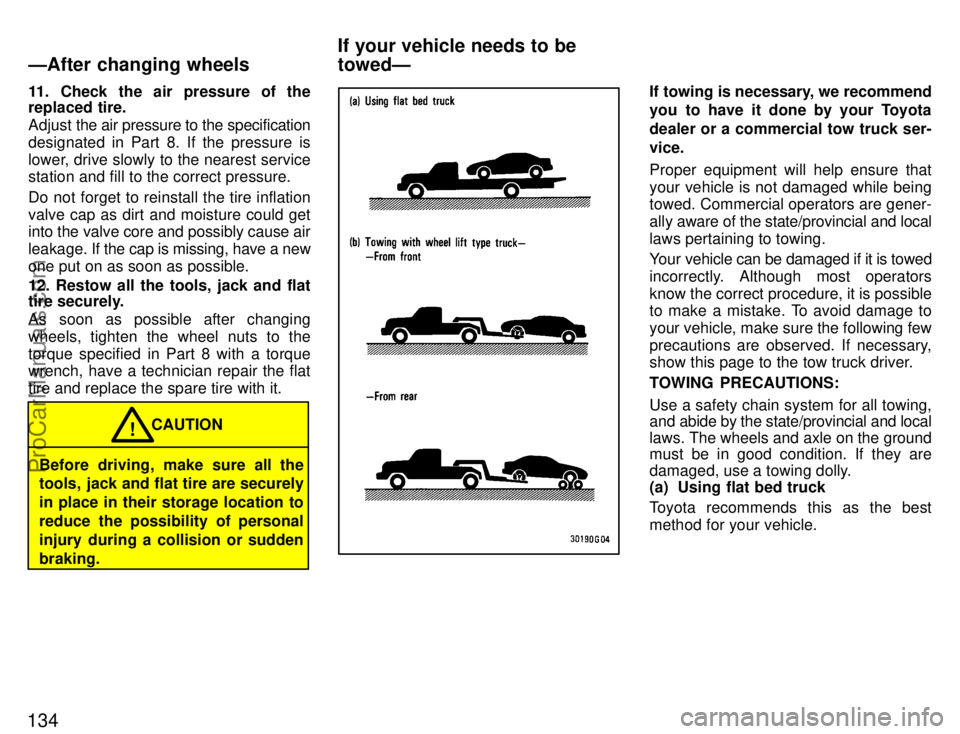Page 44 of 203

37
(B) TOP STRAP ANCHORS AND LOCA-TIONS (Coupe and liftback only)
Coupe ÐOn the filler panel behind the
rear seat
a. Using the illustration as a guide, run
your fingers across the trim of the filler
panel itself to locate the position of the
holes underneath.
b. Make a hole in the covering directly
above the hole in the filler panel.
c. Insert a 15 mm (0.6 in.) spacer and
tighten down the anchor bracket for your
child restraint system with a bolt. Torque
the bolt to 16.5±24.7 NV m (1.68±2.52 kgf-
V m, 12.2±18.2 ftV lbf). To comply with Canada Motor Vehicle
Safety Standards, vehicles sold in Cana-
da are provided with a bracket set in the
glovebox,
designed for use with any of the
2 anchor locations shown in the illustra-
tion.Liftback (right seat)ÐOn the luggage
compartment floor
a. Using the illustration as a guide, un-
cover the anchor by rolling back the car-
pet on the luggage compartment floor.
The anchor hole is sealed.
b. Remove the seal of the anchor.
c. Insert a 15 mm (0.6 in.) spacer and
tighten down the anchor bracket for your
child restraint system with a bolt. Torque
the bolt to 16.5Ð24.7 N Vm (1.68Ð2.52
kgf Vm, 12.2Ð18.2 ftl Vbf).
To comply with Canada Motor Vehicle
Safety Standards, vehicles sold in Cana-
da are provided with a bracket set in the
glovebox.
ProCarManuals.com
Page 45 of 203

38
If you remove the anchor brackets when
the child restraint system is necessary no
longer, replace the bolts in the holes to
prevent entry of exhaust emissions, water
or dirt.
Liftback (left seat)ÐOn the luggage
compartment wall
a. Using the illustration as a guide, re-
move the cap of the anchor.
b. Insert a 15 mm (0.6 in.) spacer and
tighten down the anchor bracket for your
child restraint system with a bolt. Torque
the bolt to 16.5Ð24.7 N Vm (1.68Ð2.52
kgf Vm, 12.2Ð18.2 ft Vlbf)
To comply with Canada Motor Vehicle
Safety Standards, vehicles sold in Cana-
da are provided with a bracket set in the
glovebox.
(C) INSTALLATION ON FRONT SEAT
Do not use a child restraint system which
requires use of a top strap in the front
seat. A child restraint system which re-
quires use of a top strap should only be
installed in the rear seat.
CAUTION!
� Do not use a rear-facing child re-
straint system in the front seat be-
cause the force of the rapid infla-
tion of the passenger airbag can
cause severe injury to the child.
Vehicles with a passenger airbag
display a caution label on the pas-
senger side instrument panel as
shown above to remind you not to
install a rear-facing child restraint
system on the front seat.
ProCarManuals.com
Page 141 of 203

134
11. Check the air pressure of the
replaced tire.
Adjust the air pressure to the specification
designated in Part 8. If the pressure is
lower, drive slowly to the nearest service
station and fill to the correct pressure.
Do not forget to reinstall the tire inflation
valve cap as dirt and moisture could get
into the valve core and possibly cause air
leakage. If the cap is missing, have a new
one put on as soon as possible.
12. Restow all the tools, jack and flat
tire securely.
As soon as possible after changing
wheels, tighten the wheel nuts to the
torque specified in Part 8 with a torque
wrench, have a technician repair the flat
tire and replace the spare tire with it.
Before driving, make sure all the
tools, jack and flat tire are securely
in place in their storage location to
reduce the possibility of personal
injury during a collision or sudden
braking. CAUTION
!
If towing is necessary, we recommend
you to have it done by your Toyota
dealer or a commercial tow truck ser-
vice.
Proper equipment will help ensure that
your vehicle is not damaged while being
towed. Commercial operators are gener-
ally
aware of the state/provincial and local
laws pertaining to towing.
Your vehicle can be damaged if it is towed
incorrectly. Although most operators
know the correct procedure, it is possible
to make a mistake. To avoid damage to
your vehicle, make sure the following few
precautions are observed. If necessary,
show this page to the tow truck driver.
TOWING PRECAUTIONS:
Use a safety chain system for all towing,
and abide by the state/provincial and local
laws. The wheels and axle on the ground
must be in good condition. If they are
damaged, use a towing dolly.
(a) Using flat bed truck
Toyota recommends this as the best
method for your vehicle.
ÐAfter changing wheels If your vehicle needs to be
towedÐ
ProCarManuals.com
Page 199 of 203
192
Tire size:Spare tireU.S.A. T125/70D16
Canada
7A-FE engine 185/70R14 88S
P185/70R14 87S
205/55R15 87V
P205/55R15 87V
5S-FE engine
205/55R15 87V
P205/55R15 87V
Except spare tire
7A-FE engine185/70R14 88S
P185/70R14 87S
205/55R15 87V
P205/55R15 87V
5S-FE engine
205/55R15 87V
P205/55R15 87V Tire pressure, kPa (kgf/cm2 or bar, psi):
185/70R14 88S and P185/70R14 87S Front 200 (2.0, 29)
Rear 200 (2.0, 29)
205/55R15 87V and P205/55R15 87V
Front 230 (2.3, 33)
Rear 230 (2.3, 33)
T125/70D16 420 (4.2, 60)
Wheel size:
185/70R14 88S and P185/70R14 87S 14 x 6JJ
205/55R15 87V and P205/55R15 87V
15 x 6 1/2JJ
15 x 7JJ
T125/70D16
16 x 4T
Wheel nut torque, NV m (kgfVm, ftVlbf):
103 (10.5, 76)
Engine compartment (left)-U.S.A.
Tires Fuses
ProCarManuals.com